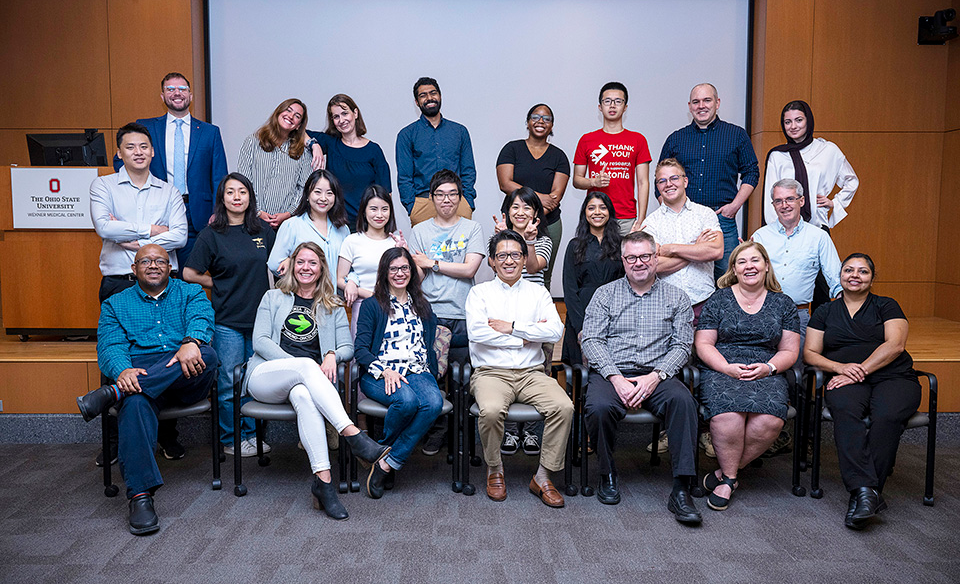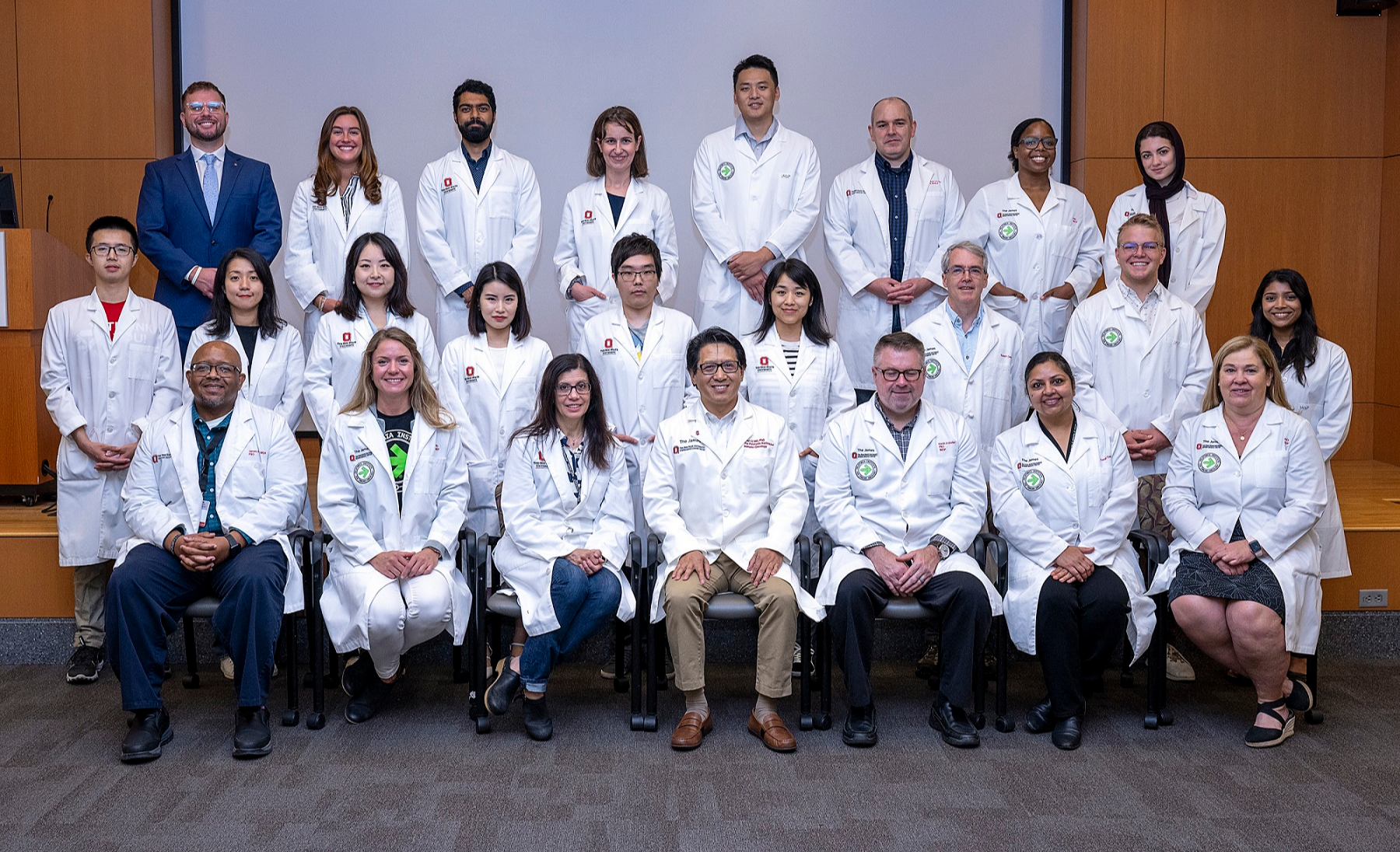Research Area
With primary interests in the mechanisms of immune regulation in cancer, Dr. Li’s research team has made seminal contributions to understanding the immunological properties of heat shock proteins in cancer immunotherapy and immune tolerance. The Team advanced the knowledge of gp96/grp94’s client network, structure-function relationship and co-chaperone CNPY3, and contributed to the understanding of this key pathway in orchestrating innate immunity, hematopoiesis, oncogenesis and developmental biology. Dr. Li and his research team currently focus on developing better immuno-therapeutics against cancer by understanding and reprogramming the tumor microenvironment, including regulatory T cells, thrombocytes and unfolded protein response as well as elucidating the roles of regulatory T cells and platelet biology in cancer immunity, untangling the key metabolic switches including unfolded protein response in inflammation and cancer, and developing cell therapy (including CAR-T) and protein
Team Description
The Zihai Li Lab focuses on chaperone biology, immune tolerance and cancer immunology, particularly related to the roles of a key immune chaperone gp96 (known also as grp94) in the endoplasmic reticulum.
Team Members
Team Show
Publications
Selected Publications:
Regarding the chaperone biology of GRP94.
a) Li Z, Srivastava PK. Tumor rejection antigen gp96/grp94 is an ATPase: implications for protein folding and antigen presentation. EMBO J. 1993 Aug;12(8):3143-51. PMCID: PMC413580. (This was the first report establishing GRP94 as an ATPase and peptide-binding protein.)
b) Yang Y, Liu B, Dai J, Srivastava PK, Zammit DJ, Lefrancois L, Li Z. Heat shock protein gp96 is a master chaperone for toll-like receptors and is important in the innate function of macrophages. Immunity. 2007 Feb;26(2):215-26. PMCID: PMC2847270. (This was the first mouse genetic study to establish GRP94 as a master chaperone for Toll-like receptors.)
c) Liu B, Yang Y, Qiu Z, Staron M, Hong F, Li Y, Wu S, Li Y, Hao B, Bona R, Han D, Li Z. Folding of Toll-like receptors by the HSP90 paralogue gp96 requires a substrate-specific cochaperone. Nat Commun. 2010 Sep 21;1:79. PMCID: PMC2982182. (This study discovered that CNPY3 is a co-chaperone for GRP94.)
d) Wu S, Hong F, Gewirth D, Guo B, Liu B, Li Z. The molecular chaperone gp96/GRP94 interacts with Toll-like receptors and integrins via its C-terminal hydrophobic domain. J Biol Chem. 2012 Feb 24;287(9):6735-42. PMCID: PMC3307303. (For the first time, the client-binding domain of GRP94 was mapped.)
Regarding the roles of GRP94 in immune tolerance and oncogenesis.
a) Liu B, Dai J, Zheng H, Stoilova D, Sun S, Li Z. Cell surface expression of an endoplasmic reticulum resident heat shock protein gp96 triggers MyD88-dependent systemic autoimmune diseases. Proc Natl Acad Sci U S A. 2003 Dec 23;100(26):15824-9. PMCID: PMC307652. (This study unveiled for the first time that overexpression of GRP94 genetically breaks tolerance and causes systemic lupus-like autoimmune diseases.)
b) Morales C, Rachidi S, Hong F, Sun S, Ouyang X, Wallace C, Zhang Y, Garret-Mayer E, Wu J, Liu B, Li Z. Immune chaperone gp96 drives the contributions of macrophages to inflammatory colon tumorigenesis. Cancer Res. 2014 Jan 15;74(2):446-59. PMCID: PMC4002507. (This study genetically linked the roles of macrophage-intrinsic GRP94 to inflammation-associated colon cancer.)
c) Rachidi S, Sun S, Wu BX, Jones E, Drake RR, Ogretmen B, Cowart LA, Clarke CJ, Hannun YA, Chiosis G, Liu B, Li Z. Endoplasmic reticulum heat shock protein gp96 maintains liver homeostasis and promotes hepatocellular carcinogenesis. J Hepatol. 2015 Apr;62(4):879-88. PMCID: PMC4369194. (This genetic study demonstrated that GRP94 plays key oncogenic roles in hepatocellular carcinoma and is a promising therapeutic target.)
d) Liu B, Staron M, Hong F, Wu BX, Sun S, Morales C, Crosson CE, Tomlinson S, Kim I, Wu D, Li Z. Essential roles of grp94 in gut homeostasis via chaperoning canonical Wnt pathway. Proc Natl Acad Sci U S A. 2013 Apr 23;110(17):6877-82. PMCID: PMC3637754. (This study discovered that GRP94 is an obligated chaperone for Wnt co-receptor LRP5/6, broadening the roles of GRP94 from peptide-binding and innate immunity to organ development, stem cell biology and oncogenesis.)
Regarding the roles of HSPs in antigen cross-presentation and therapeutic vaccines.
a) Blachere NE, Li Z, Chandawarkar RY, Suto R, Jaikaria NS, Basu S, Udono H, Srivastava PK. Heat shock protein-peptide complexes, reconstituted in vitro, elicit peptide-specific cytotoxic T lymphocyte response and tumor immunity. J Exp Med. 1997 Oct 20;186(8):1315-22. PMCID: PMC2199095. (By complexing antigenic peptides with HSPs biochemically, this study established the roles of HSPs to channel their associated peptides to MHC class I and prime CD8 T cells in vivo.)
b) Zheng H, Li Z. Cutting edge: cross-presentation of cell-associated antigens to MHC class I molecule is regulated by a major transcription factor for heat shock proteins. J Immunol. 2004 Nov 15;173(10):5929-33. (This study genetically linked the roles of antigen cross-presentation to heat shock response.)
c) Li Z, Qiao Y, Liu B, Laska EJ, Chakravarthi P, Kulka JM, Bona RD, Fang M, Hegde U, Moyo V, Tannenbaum SH, Menoret A, Gaffney J, Glynn L, Runowicz, CD, Srivastava PK. Combination of imatinib mesylate with autologous leukocyte-derived heat shock protein and chronic myelogenous leukemia. Clin Cancer Res. 2005 Jun 15;11(12):4460-8. (This was the first in-human study demonstrating the immunological roles of autologous HSP70 vaccination against leukemia.)
Regarding the roles of GARP and platelets in Treg biology and cancer immunity.
a) Zhang Y, Wu BX, Metelli A, Thaxton JE, Hong F, Rachidi S, Ansa-Addo E, Sun S, Vasu C, Yang Y, Liu B, Li Z. GP96 is a GARP chaperone and controls regulatory T cell functions. J Clin Invest. 2015 Feb;125(2):859-69. PMCID: PMC4319419. (This study uncovered that GRP94 is an essential chaperone for the function of regulatory T cells and is required for the expression of TGFβ-docking receptor GARP on the cell surface.)
b) Metelli A, Wu X, Fugle C, Rachidi S, Sun S, Zhang Y, Wu J, Tomlinson S, Howe P, Yang Y, Liu B, Li Z. Surface Expression of TGFβ Docking Receptor GARP Promotes Oncogenesis and Immune Tolerance in Breast Cancer. Cancer Res. 2016 Dec 15;76(24):7106-7117. PMCID: PMC5504525. (This study unveiled the broad expression of GARP by cancer cells, and demonstrated that GARP may serve as a diagnostic and therapeutic target for cancer.)
c) Rachidi S, Metelli A, Riesenberg B, Wu BX, Nelson MH, Fugle CW, Paulos CM, Rubinstein MP, Garrett-Mayer E, Hennig M, Bearden DW, Yang Y, Liu B and Li Z. Platelets subvert T cell immunity against cancer via GARP-TGFβ axis. Sci Immunol. 2017 May 5;2(11). pii: eaai7911. PMCID: PMC5539882. (Highlighted by May 12 issue of Science, featured on the May 2017 cover of Sci Immunol. This work, for the first time, showed that platelet-intrinsic GARP is the dominant mechanism of TGFβ activation in vivo, and suggested that immunotherapy can be potentiated by readily available anti-platelet agents.)
d) Metelli A, Wu BX, Riesenberg B, et al. Thrombin contributes to cancer immune evasion via proteolysis of platelet-bound GARP to activate LTGF-β. Sci Transl Med. 2020;12(525):eaay4860. PMCID: 31915300. (This study revealed a mechanism of cancer immune evasion that involves thrombin-mediated GARP cleavage and the subsequent TGF-β1 release from platelets.)
Regarding sex bias and cancer
a) Kwon H, Schafer JM, Song NJ, Kaneko S, Li A, Xiao T, Ma A, Allen C, Das K, Zhou L, Riesenberg B, Chang Y, Weltge P, Velegraki M, Oh DY, Fong L, Ma Q, Sundi D, Chung D, Li X, Li Z. Androgen conspires with the CD8+ T cell exhaustion program and contributes to sex bias in cancer. Sci Immunol. 2022 Apr 14. doi: 10.1126/sciimmunol.abq2630. PMID: 35420889. (This study demonstrated for the first time the T cell intrinsic roles of androgen receptor in driving CD8+ T cell exhaustion program in the tumor microenvironment.)
b) Theodorescu D, Li Z, Li X. Sex differences in bladder cancer: emerging data and call to action. Nat Rev Urol. 2022 Apr 4. doi: 10.1038/s41585-022-00591-4. PMID: 35379942. (This opinion piece summarized the inaugural symposium on sex bias and medicine hosted by Cedars-Sinai Medical Center and The Ohio State University in 2022 and called for action in studying sex as a biological factor in bladder cancer.)
Regarding the molecular mechanism of unfolded protein response (UPR).
a) Hong F, Liu B, Wu BX, Morrell J, Roth B, Davies C, Sun S, Diehl JA, Li Z. CNPY2 is a key initiator of PERK-CHOP pathway of the unfolded protein response. Nat Struct Mol Biol. 2017 Oct;24(10):834-839. PMCID: PMC6102046. (Highlighted in Nat Struct Mol Biol by Hery Urra & Claudio Hetz – “Fine-tuning PERK signaling to control cell fate under stress” [2017 Oct 5;24(10):789-790]. This study uncovered for the first time the novel roles of an ER luminal protein CNPY2 in positively regulating PERK-CHOP pathway by specifically binding to PERK and promotes its kinase activity to initiate UPR. The pathogenic roles of CNPY2 in non-alcoholic hepatic steatosis were also uncovered.)
b) Hong F, Lin CY, Yan J, Dong Y, Ouyang Y, Kim D, Zhang X, Liu B, Sun S, Gu W, Li Z. CNPY2 contributes to liver oncogenesis by promoting UPR-dependent destabilization of p53. Hepatology. 2022 Jan 5. doi: 10.1002/hep.32318. (This work links CNPY2 to oncogenesis via posttranslational regulation of p53.)
Regarding COVID-19 in patients with cancer.
a) Zeng C, Evans JP, Chakravarthy K, Qu P, Reisinger S, Song NJ, Rubinstein MP, Shields PG, Li Z, Liu SL. COVID-19 mRNA booster vaccines elicit strong protection against SARS-CoV-2 Omicron variant in patients with cancer. Cancer Cell. 2021 Dec 30:S1535-6108(21)00688-7 (This work provides evidence for the need for booster mRNA vaccinations against SARS-CoV-2 Omicon variant in patients with cancer.)
b) Song NJ, Allen C, Vilgelm AE, Riesenberg BP, Weller KP, Reynolds K, Chakravarthy KB, Kumar A, Khatiwada A, Sun Z, Ma A, Chang Y, Yusuf M, Li A, Zeng C, Evans JP, Bucci D, Gunasena M, Xu M, Liyanage NPM, Bolyard C, Velegraki M, Liu SL, Ma Q, Devenport M, Liu Y, Zheng P, Malvestutto CD, Chung D, Li Z. Treatment with soluble CD24 attenuates COVID-19-associated systemic immunopathology. J Hematol Oncol. 2022 Jan 10;15(1):5. doi: 10.1186/s13045-021-01222-y (This systems biology approach uncovered immunopathological features of severe COVID19 and the potential therapeutic value of soluble CD24 in dampening systemic inflammation and restoring of immune homeostasis.)
See My Bibliography (https://pubmed.ncbi.nlm.nih.gov/?term=zihai+li&sort=date&size=200) for additional information (205 PubMed-indexed publications).


